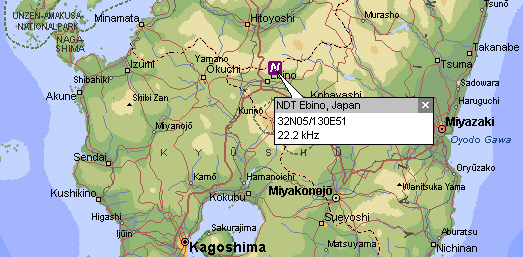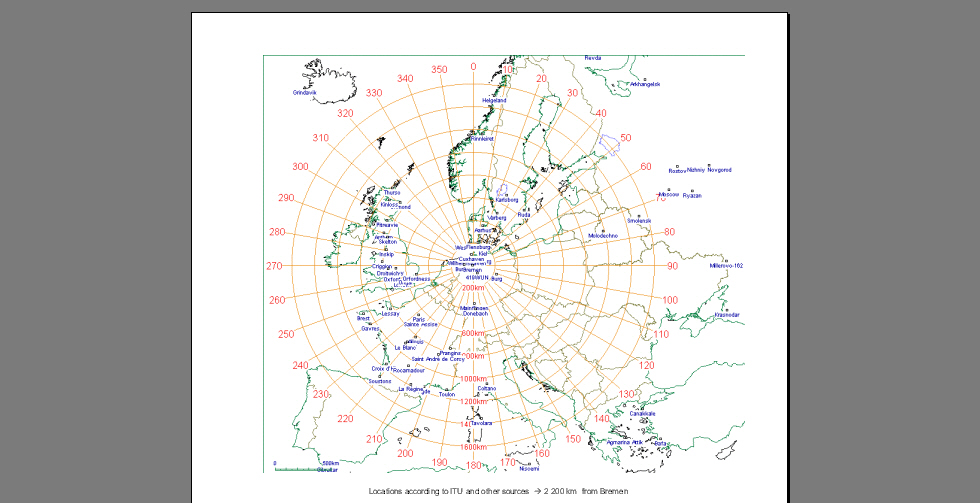 map  |
RDF PROJECT |
This site is an open lab for RDF work covering the frequency range of 0 to 150 kHz We welcome your bearings for signals received in this band. We don't log frequencies without correlated bearings. We are always glad of links to further information. |
Please submit logs and any information to |
Contents |
| Description of the Project |
 map  |
|
How to
get started The first thing you need is a receiver. For frequencies from 5 Hz to 24 kHz most soundcards will be ok. Build a loop (e.g. 40 turns on a 30 cm diameter former), hook it up at a place well away from iron structures and electronic gear and connect it to the mic input of the card for a test. Run GRAM using the settings shown in fig 1. Be sure that the mic input is active (test it with the tip of your finger).
If there is a VLF station nearby you may get a picture like fig 2. The huge peak origins from DHO38 on 23400 Hz. This station stands litterally "in my backyard". Another peak is GBR on 15975 Hz which went silent in 2003.
You can increase the sensitivity of
this setup by a simple preamp. You can choose from
one of the following designs:
By
turning the loop you should be able to null out the
different stations one by one. The following screen shots were taken at the same time (280602-065700utc). Note the differences for different settings of GRAM and different directions of the antenna respectively.
11 to 24 kHz in scroll mode, bearing 0/180°
11
to 24 kHz in line mode, bearing 0/180°
|
|
Sample Band Scans |
|
Band scan July
29, 2003 233500 utc -
loop receiving signals from eastern and western
directions - nighttime
|
 Band scan July
30, 2003 074100 utc -
loop orientation as above -
daytime - weak TV line
frequency - 23.4 kHz
maintenance break - 22.1 kHz
active -
|
 Band scan July
30, 2003 082830 utc -
loop orientation as above -
23.4 kHz back - 18.1
kHz active
|
|
Logs Location: Bremen, Germany (53N/8E) (JO43KB) Station : Single turn loop of 80 cm diameter + amplifier + various receivers |
Frequency kHz |
Call |
Country |
Location, Modulation |
Coordinates latitude/longitude |
Date year |
Bearing/ ° |
|
11.905 |
NAVAID, |
RUS |
3 LOCATIONS, PULSES |
see Renato's site |
|
|
|
12.091 |
NAVAID, |
RUS |
REVDA, PULSES (4th location) |
68N02/34E41 see Renato's site |
2006 |
23.5 |
|
12.649 |
NAVAID, |
RUS |
3 LOCATIONS, PULSES |
see Renato's site |
2006 |
23/49/96 |
|
13.000 |
VL3DEF |
AUS |
WOODSIDE |
38S29/146E56 |
2004 |
|
|
|
|
|
|
68N02/34E41 |
|
|
|
14.881 |
NAVAID, |
RUS |
3 LOCATIONS, PULSES |
see Renato's site |
|
|
|
15.625 |
|
|
|
68N02/34E41 |
|
|
|
16.000 |
GBR |
GB |
RUGBY |
52N22/1W11,u |
2003 |
|
|
16.400 |
JXN |
NOR |
HELGELAND, |
66N25/13E01, u 66N58/13E54, ANTENNA SITE |
2006 |
5 5 |
|
17.000 |
|
|
|
|
|
|
|
17.200 |
SAQ |
SWE |
VARBERG/GRIMETON, CW pictures see here |
57N07/12E24 |
2006 |
- |
|
18.100 |
RDL uu |
RUS |
KRASNODAR, MSK, CW ARKHANGELSK MSK, CW ?, MSK, CW KRASNODAR, MSK, CW ARKHANGELSK, MSK, CW |
45N02/38E39 64N22/41E35 ? 45N02/38E39 64N22/41E35 |
2006 |
118 55 55 100 42 75 |
|
18.200 |
VTX3 |
IND |
VIJAYANARAYANAM, MSK |
8N26'55''/77E44'43'' |
2006 |
|
|
18.300 |
HWU, uu |
FRA |
LE BLANC (Rosnay), MSK, uu |
46N37/1E05 |
2005 |
218 |
|
18.500 |
DHO35 |
GER |
BURLAGE,RAMSLOH, MSK |
53N05/7E37 |
2006 |
272 |
|
|
|
|
|
|
|
|
|
18.900 |
UMB/RDL? |
RUS |
ROSTOV?, MSK |
57N14/39E48 |
2005 |
88 |
|
19.200 |
|
|
|
|
|
|
|
19.600 |
GBZ |
GB |
FINAL TRANSMISSION FROM |
52N43/3W04 |
2003 2008 |
292 |
|
19.800 |
NWC |
AUS |
H.E. HOLT/NORTH WEST CAPE/ EXMOUTH |
|
|
|
|
20.270 |
ICV |
ITA |
TAVOLARA, MSK |
40N55/9E45 |
2006 |
175 |
|
20.500 |
RJH63/66/77 |
RUS |
ARKHANGELSK, etc |
64N22/41E35 see Renato's site |
2006 |
77, 105 |
|
20.900 |
HWU(?), uu |
FRA |
SAINTE ASSISE, MSK, uu |
48N33/2E34 |
2006 |
222 |
|
21.100 |
RDL, uu |
RUS |
various, CW, MSK, uu |
various |
2005 |
see 18.1 |
|
21.750 |
HWU |
FRA |
LE BLANC (Rosnay), MSK |
46N37/1E05 |
2006 |
220 |
|
|
|
|
|
|
|
|
|
22.200 |
NDT |
JAP |
EBINO |
32N05/131E51 |
2006 |
- |
|
23.400 |
DHO38 |
GER |
BURLAGE,RAMSLOH, MSK picture see here |
53N05/7E40 |
2006 |
276 |
|
24.000 |
NAA |
USA |
CUTLER, ME, MSK |
44N38/67W17 |
2006 |
|
|
25.000 |
RJH77 |
RUS |
ARKHANGELSK, CW, PULSES |
64N22/41E35 |
|
75 |
|
25.200 |
NML4 |
USA |
LA MOURE, MSK |
46N22/98W20 |
2005 |
315 |
|
26.700 |
TBB |
TUR |
BAFA, MSK |
37N28/27E30 |
2005 |
|
|
27.350 |
RDL, uu |
RUS |
?, MSK |
? |
|
|
|
36.000 |
DHO37 |
GER |
BURLAGE, RTTY |
53N05/7E37 |
2006 |
272 |
|
37.500 |
TFK/NRK? |
ICE |
GRINDAVIK, RTTY |
63N57/22W28 |
2006 |
|
|
38.000 |
SRC/SHRu |
SWE |
RUDA, MSK, CW, 50BD,160HZ |
57N12/16E18 |
2003 |
36 |
|
40.400 |
SAS/SRC?u exSAS2 |
SWE |
|
58N29/14E29 |
2006 |
25 |
|
40.750 |
NAU |
P.RIC |
AGUADA, RTTY |
18N23/67W11 |
2006 |
270 |
|
44.200 |
|
|
|
|
|
|
|
45.900 |
NSY |
ITA |
|
37N06'16''/14E6'25'' |
2006 |
|
|
49.000 |
SXA |
GRE |
AGMARINA ATTIK, RTTY |
38N11/24E04 |
2005 |
|
|
51.950 |
GYA? GYW1? GIZ1? MTO? |
GB |
THURSO, RTTY |
56N36/3W30 |
|
|
|
53.000 |
DHJ59 |
GER |
WILHELMSHAVEN,RTTY |
53N33/8E05 |
2000 |
|
|
53.400 |
TBG |
TUR |
KANAKKALE, RTTY |
40N06/26E26 |
2005 |
|
|
53.700 |
RTO |
RUS |
MOSKVA, RTTY |
55N45/37E38 |
2000 |
|
|
56.350 |
GLP20 |
GB |
ONGAR, RTTY |
51N43/00E11 |
2000 |
|
|
57.400 |
GXH |
GB |
THURSO, RTTY |
56N36/3W30 |
2005 |
|
|
57.700 |
LBA/H |
NOR |
TRONDHEIM, RTTY, u qrt spring 2007, antennas still standing
RINNLEIRET |
63N25/10E30, u |
2008 |
|
|
60.000 |
MSF |
GB |
RUGBY, TIME |
52N22/1W11 |
2005 |
|
|
|
GIZ20? |
GB |
SKELTON?, RTTY ANTHORN? |
? |
2005 |
|
|
62.600 |
FUG |
FRA |
LA REGINE, RTTY |
43N23’30’’ / 2E6’14’’
|
2005 |
|
|
|
FUE |
FRA |
BREST, RTTY |
48N25/04W14 |
2005 |
|
|
|
66.700
|
|
|
|
|
|
|
|
68.000 |
GBY20? |
GB |
RUGBY, RTTY THURSO? |
52N22/1W11 58N36/3W30 |
2001 |
|
|
68.900 |
DHJ58 |
GER |
FLENSBURG, GLÜCKSBURG,RTTY |
54N50/9E32 |
2000 |
|
|
73.600 |
CFH |
CAN |
|
|
2006 |
|
|
75.000 |
HBG |
SWI |
|
46N24/01E15 |
2006 |
|
|
77.500 |
DCF77 |
GER |
|
50N01/09E00 |
2006 |
|
|
81.000 |
GYN2? |
GB |
SKELTON?, RTTY |
54N43/2W53? |
2005 |
|
|
82.750 |
|
GB |
CRIMOND?, CARRIER |
? |
2005 |
|
|
87.000 |
ALC? |
USA? |
FAIRBANKS, ALASKA?, RTTY |
64N50/147W43 |
2000 |
348 |
|
|
|
|
|
|
|
|
|
122.300 |
OUA |
DK |
ARHUS, RTTY |
56N10/10E13 |
2000 |
190 |
|
129.000 |
DCF49 |
GER |
MAINFLINGEN, ASCII |
50N01/09E00 |
2005 |
178 |
|
135.820 |
SXV/SXA? |
GRE |
SPATA ATTIKIS ATHINAI, RTTY |
37N58/23E55 37N55/23E49 |
2000 |
132 |
|
137.xxx 137.100 |
CFH? ? |
CAN? ? |
HALIFAX? RTTY ?, CARRIER |
44N58/63W59 ? |
2000 |
293 165/345 |
|
139.000 |
DCF39 |
GER |
BURG, PULSES, ASCII |
52N17/11E54 |
2006 |
|
|
|
DDH47 |
GER |
PINNEBERG, RTTY, METEO picture see here |
53N41/09E41 |
2006 |
|
abc = no logs in 2005 or shut down uu = different stations using different frequencies/same call |
|
v0.98e
|
||||||||||||||||||||||||||||||||||||||||||||||||||||||||||
| Links |
|
Kiel Longwave Monitor at 54N/10E :
http://lf-radio.de |
| Visit Renato Romero's OPEN LAB SITE : www.vlf.it |
| Join the LWCA : www.lwca.org |
|
RETURN TO
THE MAIN INDEX OF RBW 22 |
| 03-06-2016 |